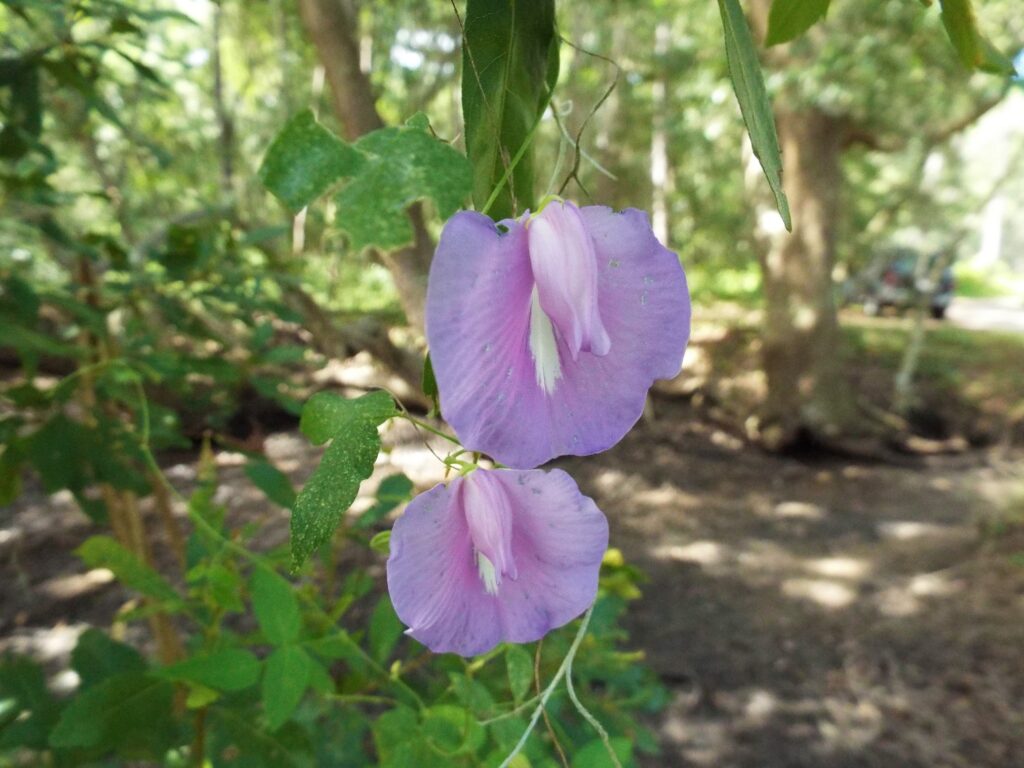
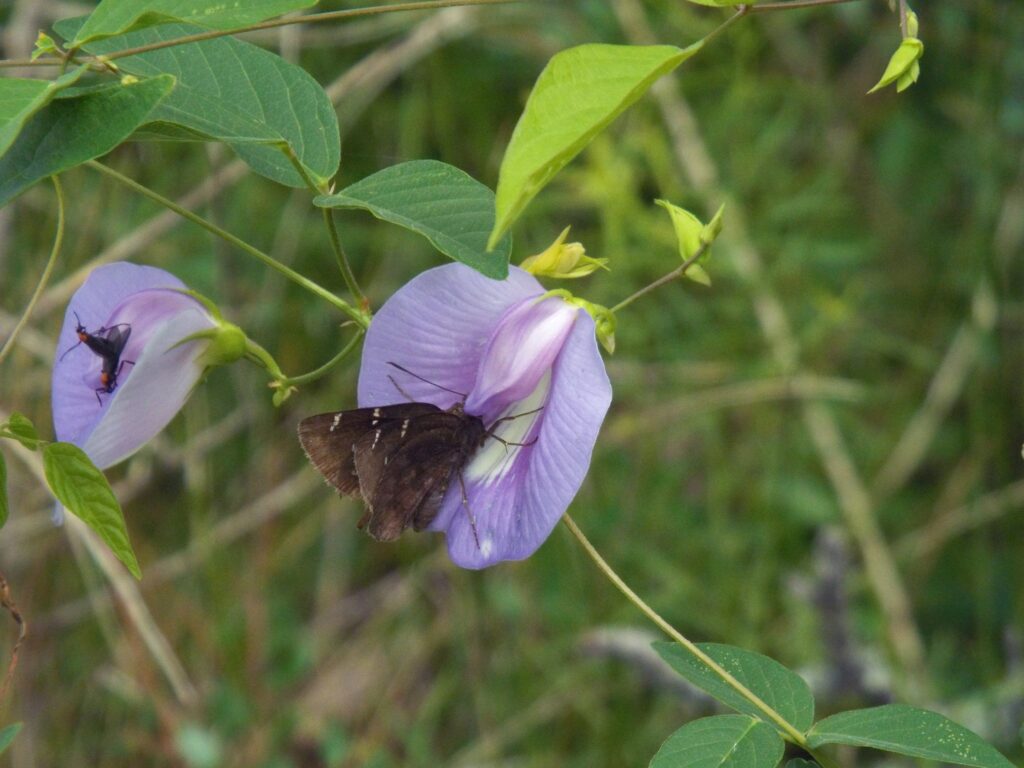
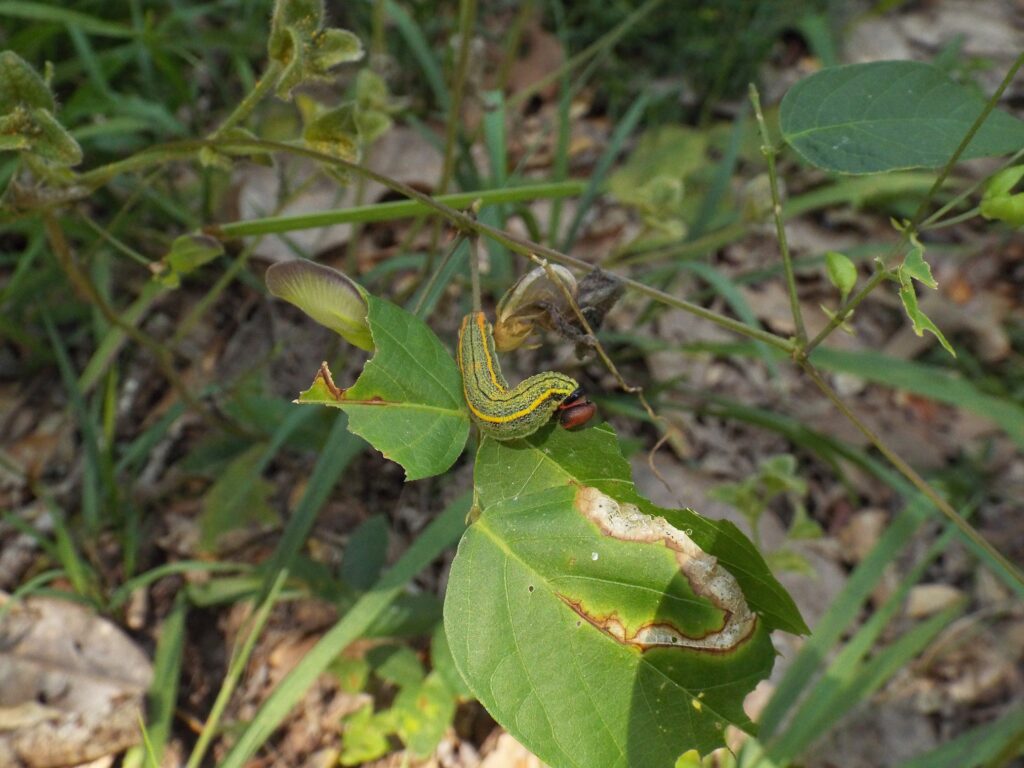
This week for Flora and Fauna Friday blooms a winding purple pendant hung upon the nape of the forest, Spurred Butterfly Pea (Centrosema virginianum).
Spurred Butterfly Pea is a common sight in fall here on Edisto Island. Its thin vine is often spotted draped across a small shrub or twined around a flower stem atop a sunny, sandy tree line. Its sparse three-fingered leaves and delicate stem do little to hinder the growth of its host. Spurred Butterfly Pea is a member of the legumes and can fix nitrogen. It also has a very large and very pea-like flower that’s nearly two inches around and a soft pastel-purple with a snow white streak down the center.
Spurred Butterfly Pea is a decent pollinator plant that’s appreciated by smaller butterflies but adored by one in particular, the Long-tailed Skipper. The Long-tailed Skipper is a medium sized butterfly with a pair of long tails on its gray-brown wings and a brilliant iridescent-turquoise back. Its caterpillars eat various species of legume including, garden beans, but most relevant is Spurred Butterfly Pea. It’s rare to find a patch of Butterfly Pea that doesn’t have a colony of Long-tailed Skippers in tow. The caterpillars of Long-tailed Skippers can easily be spotted by their handiwork. They’re leaf rollers who’ll fold a rectangular flap of leaf atop themselves to eat in privacy and relative safety until they’re large enough to fold a whole leaf over. Many of you gardeners may know them instead as Bean Leafrollers, as they’re a common pest of Garden Beans and Cowpeas. However, in the wild, Spurred Butterfly Pea is the palate’s preference.
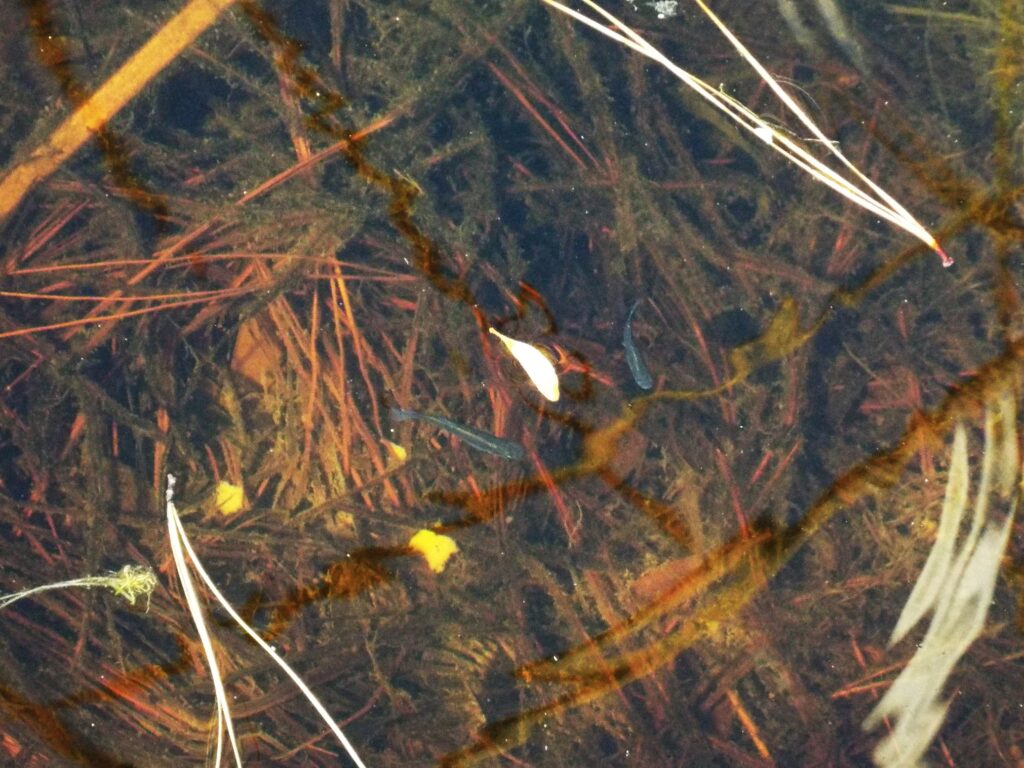
This week for Flora and Fauna Friday we have a minute mosquito munching minnow, the Eastern Mosquitofish (Gambusia holbrooki).
The Eastern Mosquitofish is native to the southeastern United States. Here in the Lowcountry, it can be found in practically ever permanent freshwater body of water, from the largest lake and the widest swamp to the shallowest woodland pool and narrowest wet ditch. They can be found everywhere and easily found. A quick scan of a pond edge will almost certainly uncover a half dozen Mosquitofish lazily swimming just below the surface. Mosquitofish are only an inch or two in length with the profile of an elongated teardrop from above. From the side they have a mostly rectangular shape with an upturned mouth and a slight pot-belly. Their coloration is a drab mix of translucent gray and greenish-brown, sometimes with a black bean-shaped spot at the back of the abdomen. They’re a very no non-sense fish. They provide a very clear ecosystem service, mosquito control. Mosquitofish primarily eat algae and plant detritus but, when afforded the opportunity, they’ll eat their fair share of aquatic invertebrates.
As you know, mosquitoes lay their eggs in stagnant pools of water. They do this so their larvae can avoid predators. Those eggs hatch into free swimming larvae that feed on plankton until metamorphosing into blood-sucking annoyances. Well, Mosquitofish just so happen to love living in stagnant water bodies. So a large reason as to why mosquito populations aren’t any worse than they are is because of today’s dear old Mosquitofish. Mosquitofish are specially adapted to life in shallow, hot waters with dangerously low oxygen and pH levels as well as other water chemistries that are deadly to many fish. Mosquitofish seek out these inhospitable wetlands for their own safety, as few other fish will follow them here. However, Mosquitofish are still very common on the fringes of large water bodies as their small size allows them to stick right up against the water’s edge and out of harms way.
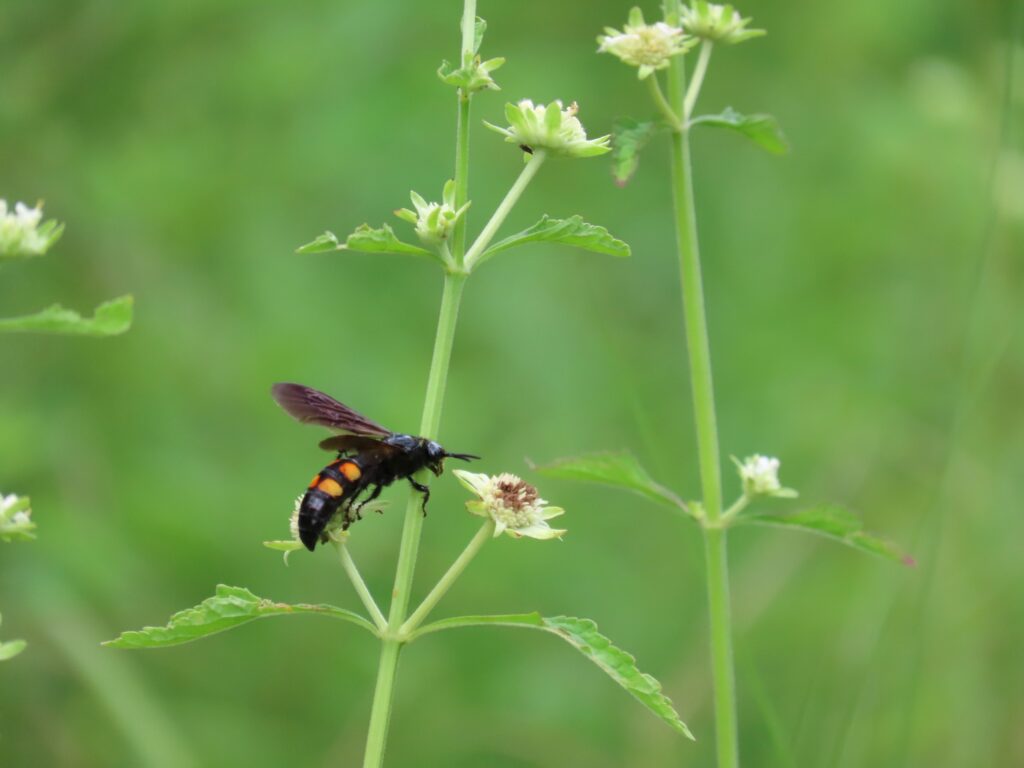
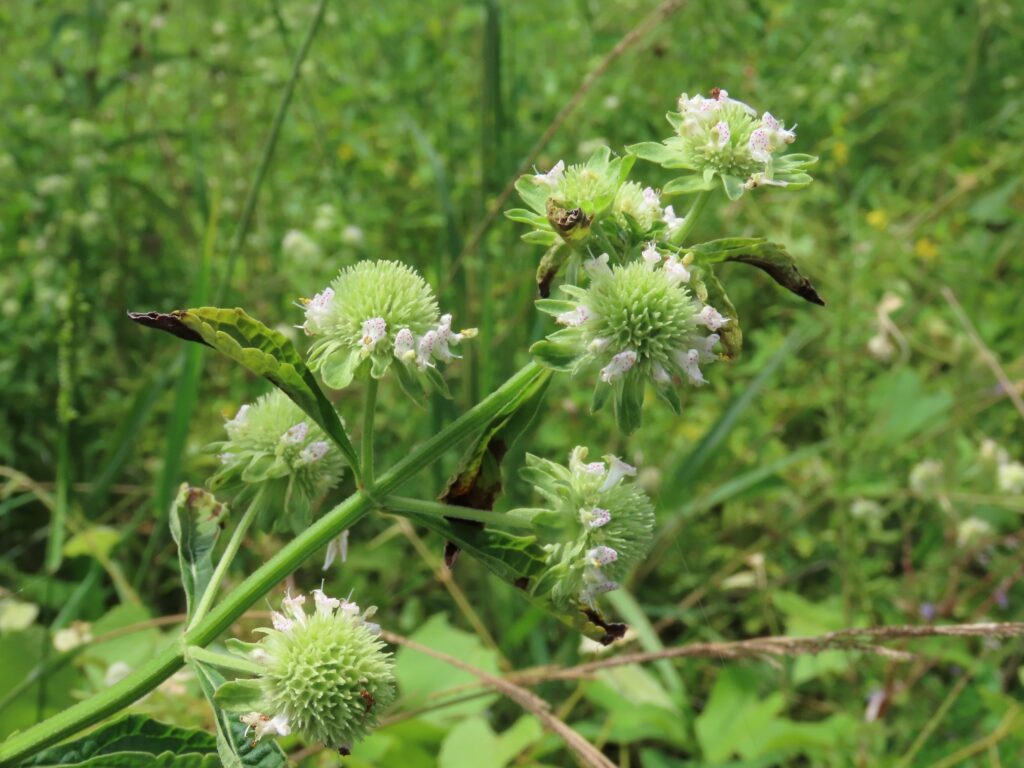
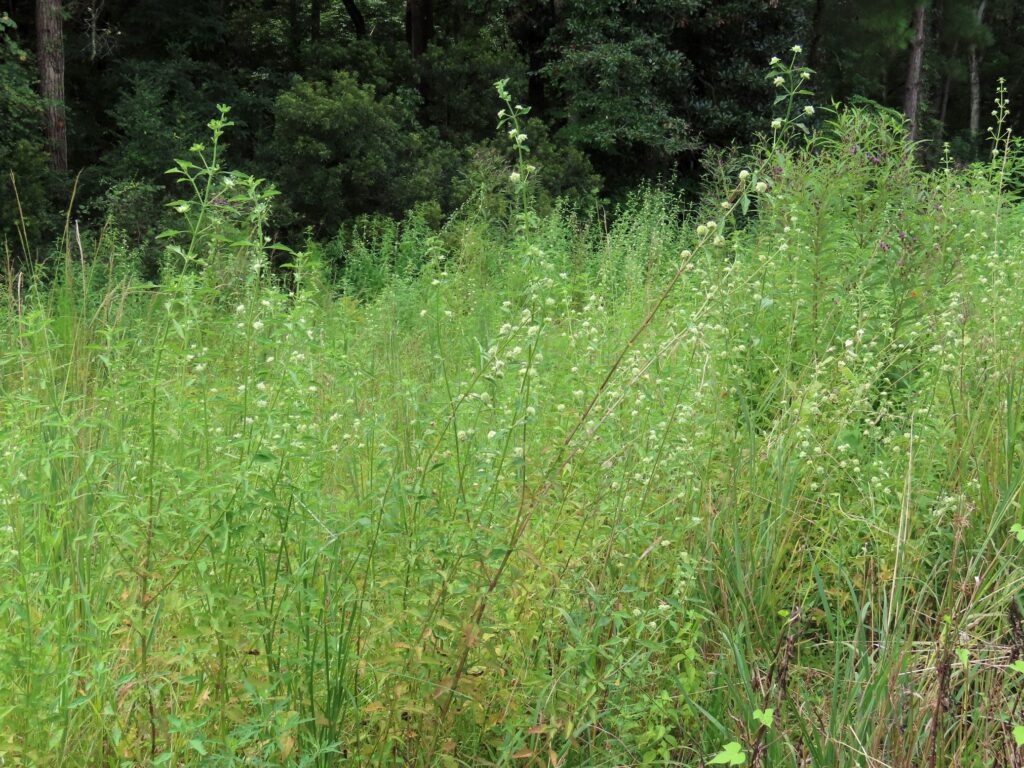
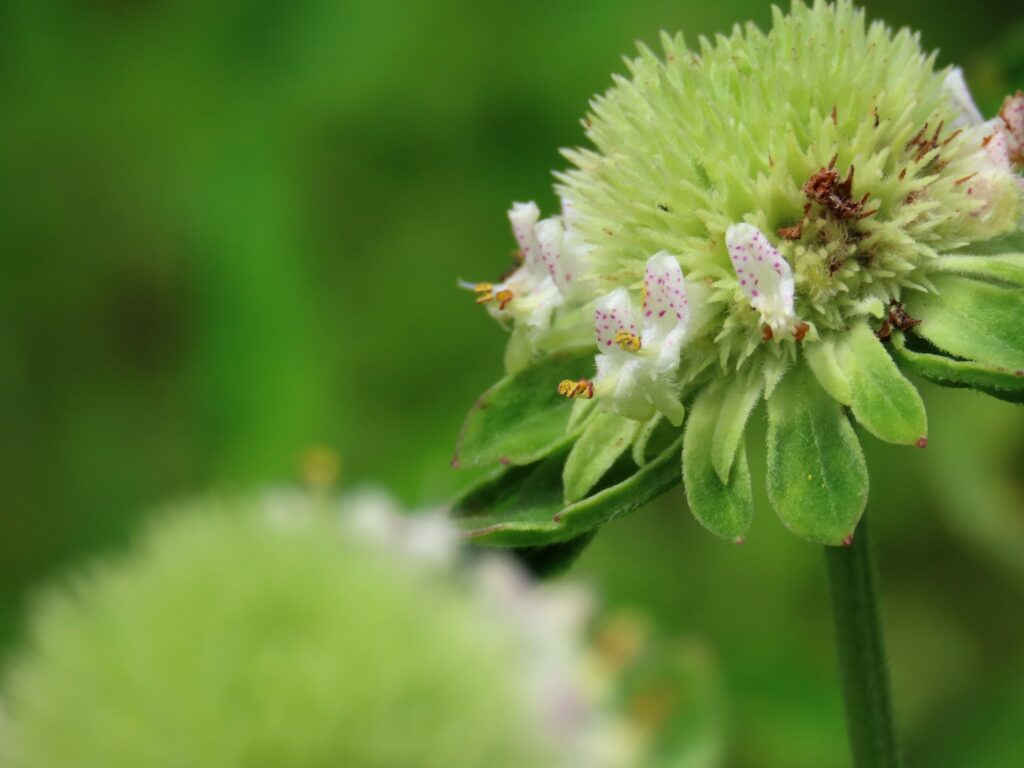
This week for Flora and Fauna Friday it’s another pollinator approved native wetland wildflower, Clustered Bushmint (Hyptis alata).
Clustered Bushmint is a perennial wildflower found all throughout the Southeastern coastal plain, including the Lowcountry of South Carolina and Edisto Island. Its favorite places to populate are the sandy slopes of sunny dirt road ditches or saturated swales sunk in beside the highway. It loves wet acidic sandy soils and full sun. Clustered Bushmint grows to about chest high with a narrow woody stem and a sparse collection of small leaves. Sometimes they bare a single straight stem, other times it branches broadly. However, that stem is not as barren as it sounds as it will soon be ringed in flower-heads from the first foot above the ground all the way to its tip. The flower-heads of Clustered Bushmint are pale green and spherical with a whorl of bracts collaring them from below. Atop this flower-head poke out individual flowers, tiny and white with magenta polka-dots. Clustered Bushmint blooms from August through September and is adored by pollinators of all shapes and sizes. Its tiny flowers are easy for flies, beetles, and wasps to sip from but their clustered presentation creates a perfect landing pad for larger and heavier butterflies and bumblebees to clamber onto.
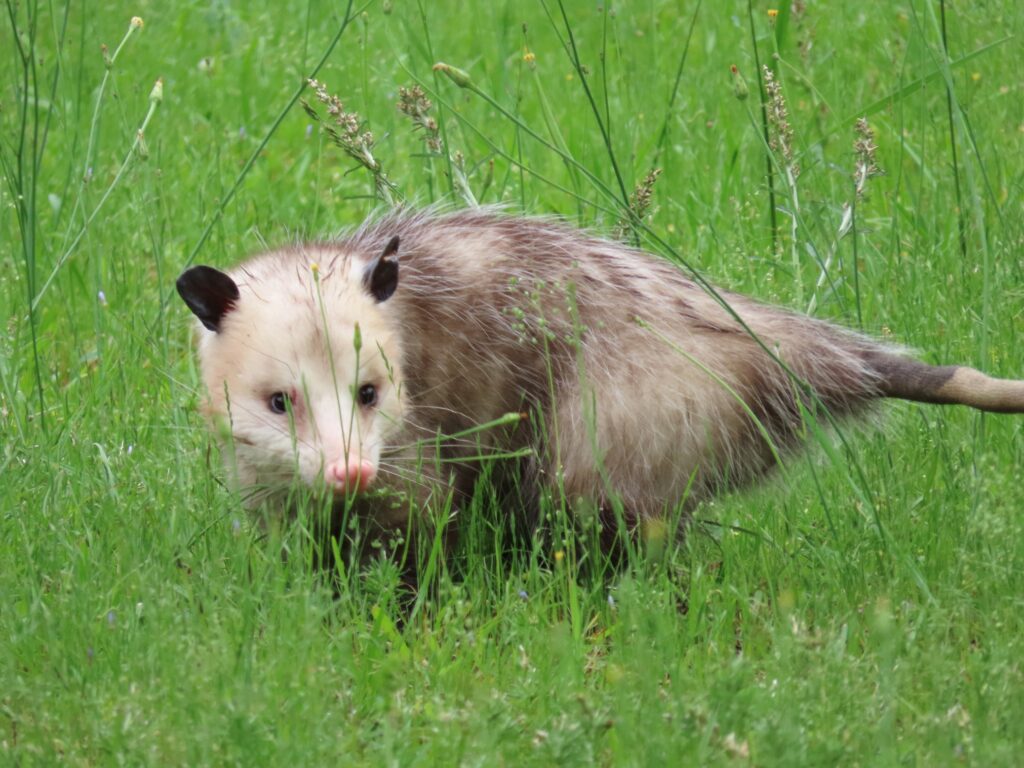
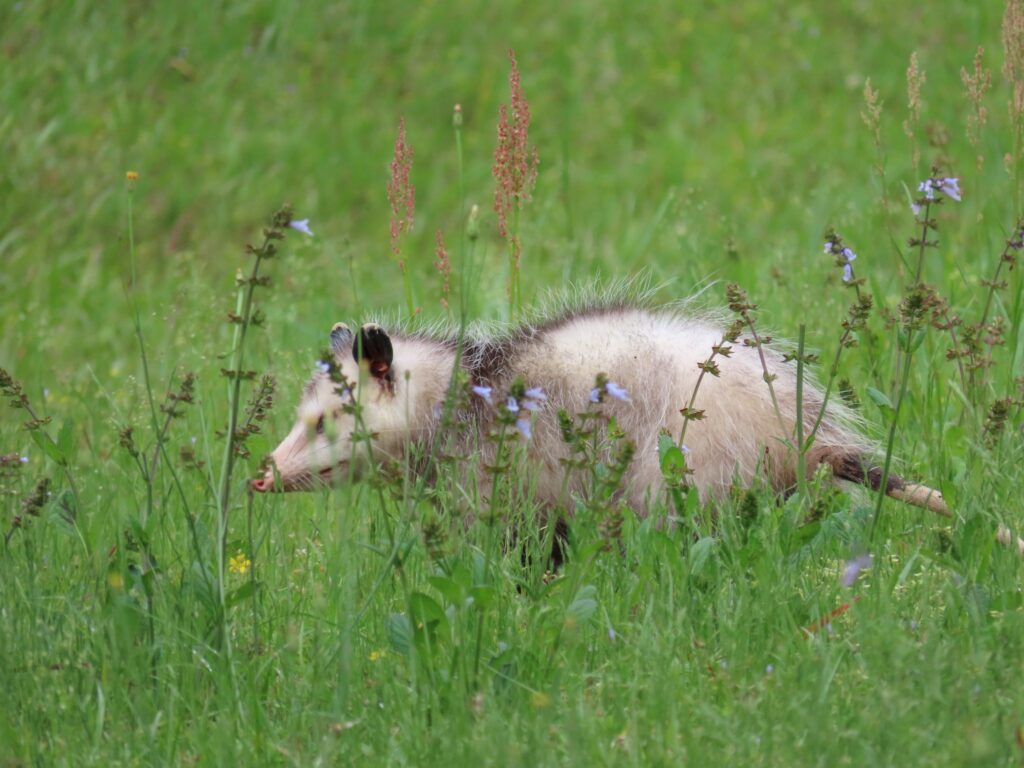
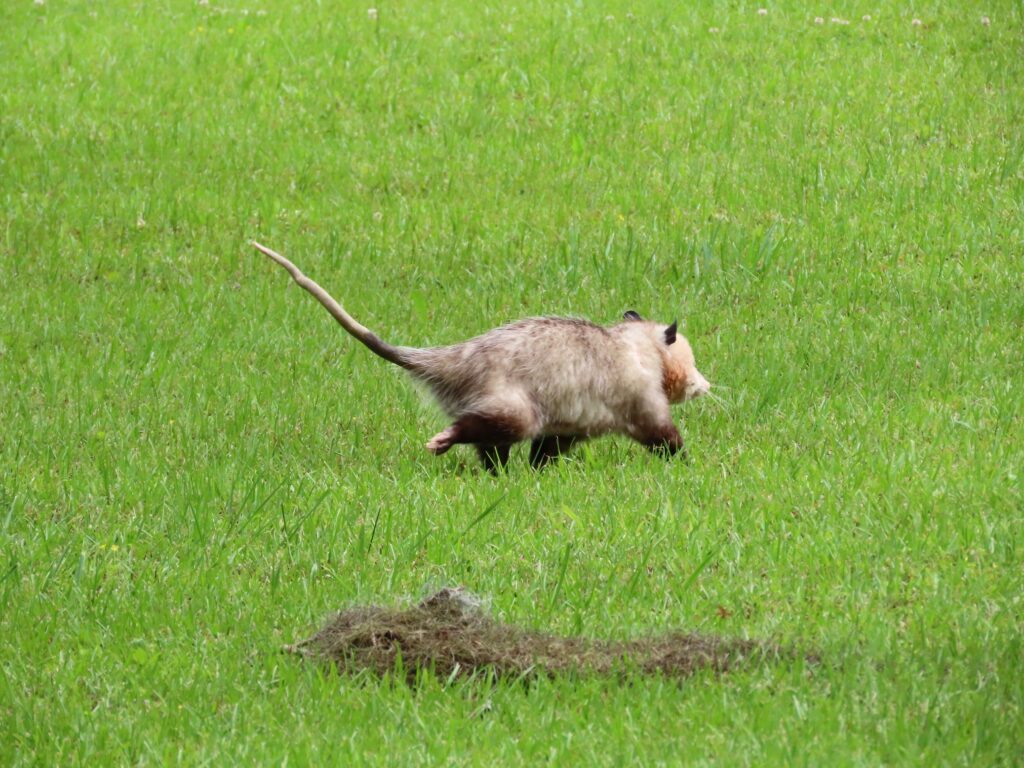
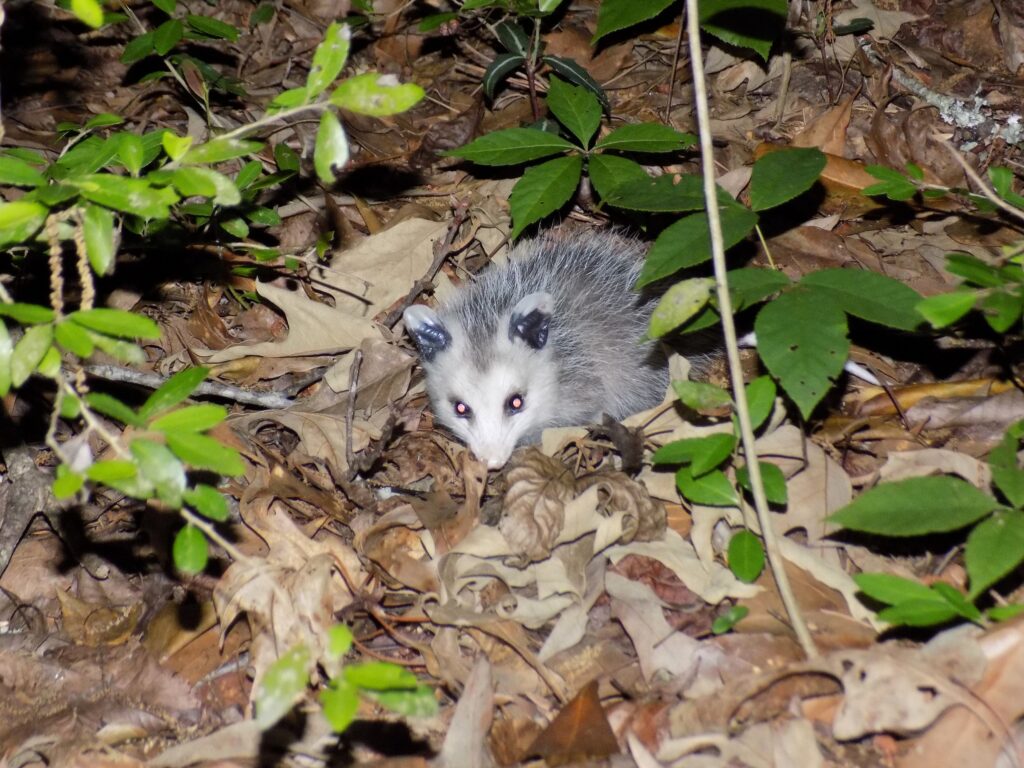
This week for Flora and Fauna Friday we have our one and only North American marsupial, the Virginia Opossum (Didelphis virginiana).
The Virginia Opossum is by all measures a strange beast. Just like the Armadillo, there’s no way I can cover all its unique traits in one post, so I’ll give you some highlights. But first, we’ll start with a description. Our Opossum is a medium sized mammal about the size of a cat. Their fur is thick, short, and frizzy, blending from an ivory white on the face to a dingy brownish-gray highlighted by bright white bristles across the body and then darkening down around the knees to a charcoal black. Their body is bulky and their head large and pointed, with small black ears, forward facing eyes, and little pink nose. On the reverse their tail is thick and hairless and held outstretched as they saunter through the forest. Opossums are not a creature in a hurry. Their gait is short and their pace is relaxed, as if they’re simply out for an evening stroll. One of the unique things about our Opossum is that they are the only marsupial native to North America. Marsupials give birth to under-developed live young. Those young then spend the next stage of their life sleeping and nursing in their mother’s pouch on her belly until they’re big enough to survive the elements. Mother Opossums can often be seen with her litter of little ones clinging to her back as she strolls through the understory.
Opossums can be found throughout the Eastern United States in woodland habitats. They’re predominantly nocturnal and split their time between the forest canopy and its floor. They have several unique adaptation for life in the tree tops, including opposable rear thumbs and a prehensile tail, both of which can easily wrap around tree branches. Opossums are true omnivores and they will eat just about anything, including fruits, frogs, crabs, seeds, insects, carrion, eggs, and, most notably, ticks and snakes. Opossums have a nose and a taste for ticks and will scarf down any they encounter as they wander the woods. Opossums are also extremely resistant to snake venom and can be a major predator of young vipers. They also have quite the taste for chicken, both chicken eggs and the hens themselves, and they can be a major nuisance for folks keeping chickens. As those folks likely know, Opossums have an interesting defense strategy. When cornered, Opossums tend to just sit there and hiss, head low and mouth agape. Opossums also hold the title for the most teeth of any mammal in North America, so it’s not an unimpressive bluff. They’re not really aggressive and they’re pretty much the opposite of nimble. If their initial bluff fails, they sometimes go all in instead of running. Opossums are known for playing dead. When assaulted, they can go limp with their eyes wide open, lips curled back, and while releasing a horrid aroma, all of which is pretty convincing to most unenthusiastic predators that said Opossum actually kicked the bucket a week ago and is not fit for eating. It doesn’t work out for the Opossum all the time but it works often enough that’s it’s worth them trying.
The Edisto Island Open Land Trust has received a $171,512 grant from the Department of Interior, National Park Service (NPS) funded through the Historic Preservation Fund and African American Civil Rights grant program, for the restoration of the interior of the Hutchinson House. 53 of these grants totaling $15,035,000 were awarded for projects across the United States. With these funds, organizations and agencies conserve significant U.S. cultural and historic resources, which illustrate, interpret, and are associated with the great events, ideas, and individuals that contribute to our nation’s history and culture.
“This competitive grant program is just one of the many ways the National Park Service is working to preserve and interpret the lesser-known facets of our nation’s shared history,” said NPS Deputy Director Shawn Benge. “From physical restoration projects to surveys, documentation, and education, this years’ grant funds will help many of our State, Tribal, local, and non-profit partners advance their preservation goals.”
The Hutchinson House represents one of the oldest houses on Edisto identified with the African American community after the Civil War. In 1885, Henry Hutchinson married Rosa Swinton, and according to oral tradition, he built what is now known as the Hutchinson House as a wedding gift for her. He constructed the house with his half-brother Jack Miller and their uncle John Pearson Hutchinson, a self-taught architect who built Central Baptist Church in Charleston. Henry acquired the property the house is built on from his father, James “Jim” Hutchinson.
Jim Hutchinson was born into slavery at Peter’s Point Plantation on Edisto Island. After serving in the Union Navy during the Civil War, Jim became a political activist. He served as the Republican precinct chairman on Edisto Island, facilitating the election of Black legislators and registering Black voters in large numbers. He perpetually advocated for the economic empowerment and fair treatment of African Americans while promoting Black land ownership. Jim thrust himself into civil rights activism during a very difficult transitional period in our history, and it may have cost him his life. He was murdered on the Fourth of July, 1885, by a white man from Wadmalaw. Many people at that time believed Jim was murdered because of his advocacy for Black equality.
The Hutchinson House was listed on the National Register of Historic Places in 1987, and today, stands as an important example of the strength and resilience of an African American family on Edisto Island. The house represents the high level of craftsmanship and design that African Americans were able to achieve in their own homes once out from under White suppression. After Henry and Rosa passed away, two more generations of the Hutchinson family lived in the house and the property remained under their ownership from 1875 to 2016. It is a testament to the Hutchinson family’s success and represents the perseverance of formerly enslaved people in the decades following the Civil War.
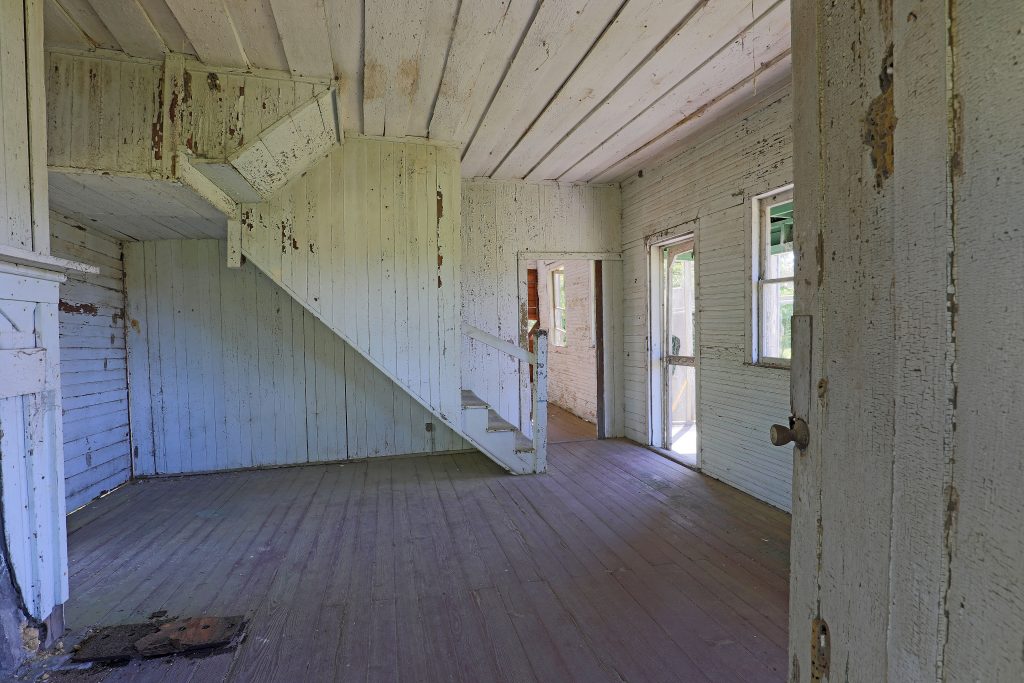
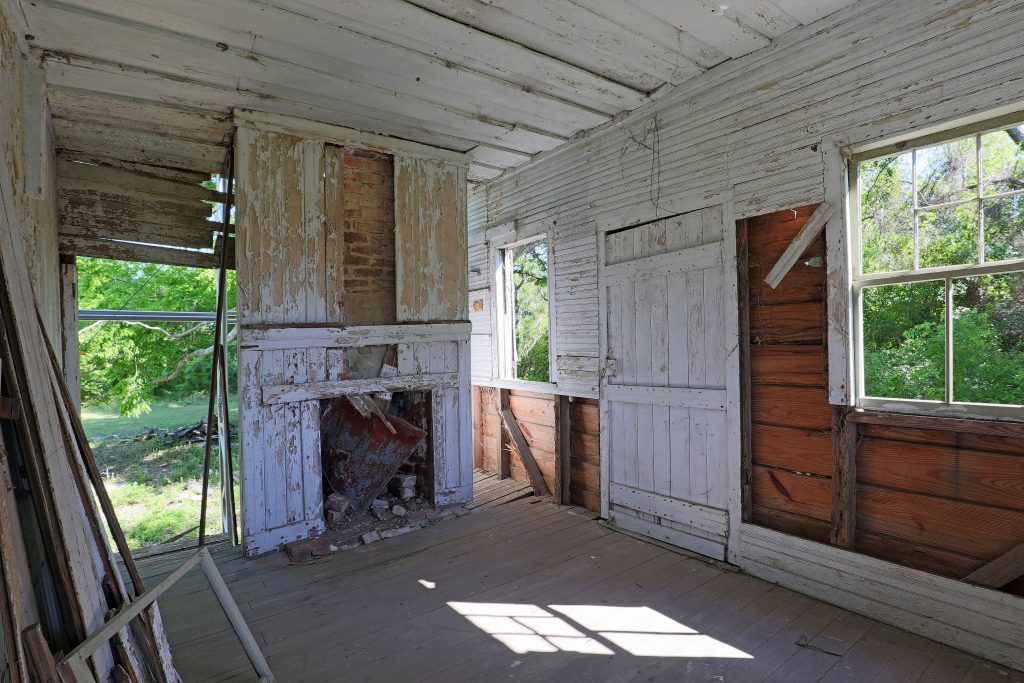
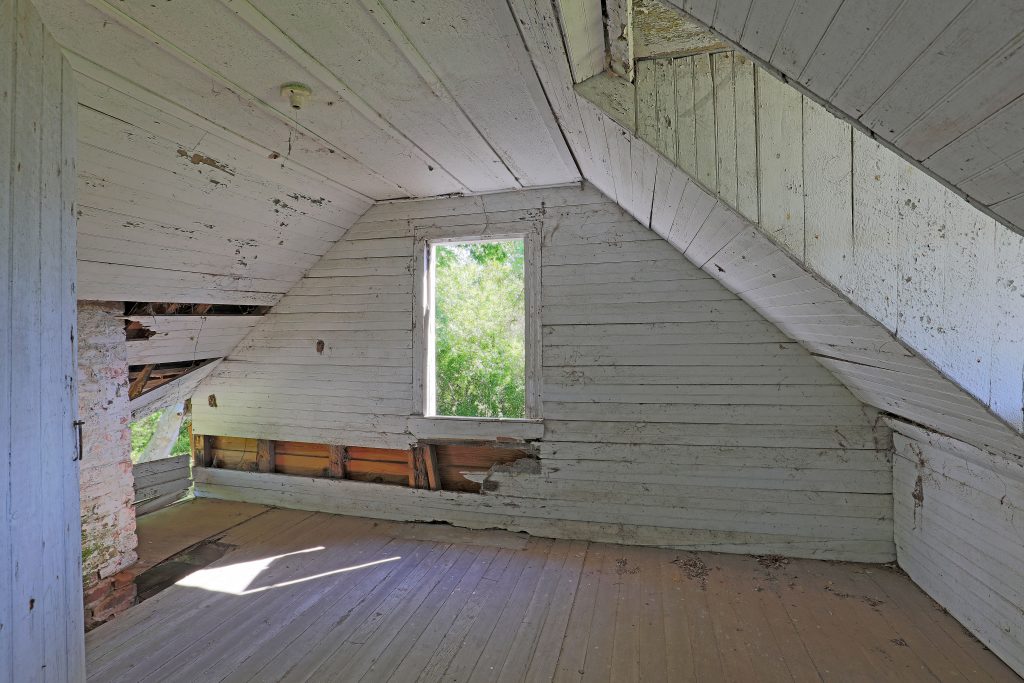
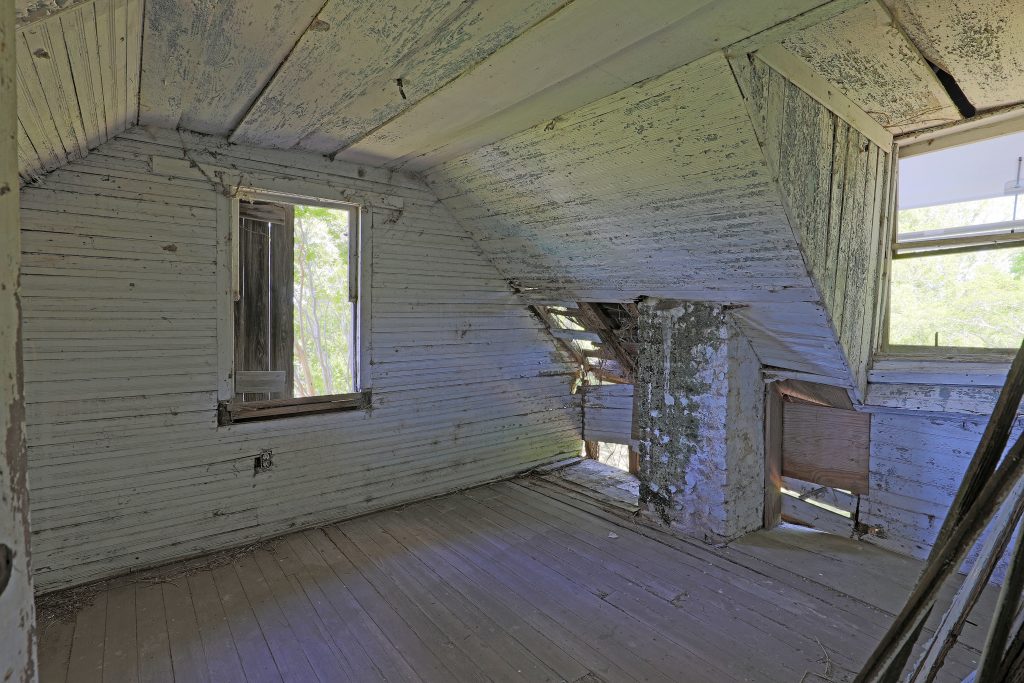

Once the restoration of the Hutchinson House is complete, it will be open to the public as a museum and heritage center. Funds are still being raised to complete the replication of the three-sided porches and rear room that was original to the house. To find out more about this important heritage project, you can visit the EIOLT website at www.edisto.org. For more information on this project please contact EIOLT at 843-869-9004. For questions regarding the Historic Preservation Fund and African American Civil Rights grant program, or to comment on this or any other proposed Historic Preservation Fund grant project, please contact the State, Tribal, Local, Plans & Grants Division, National Park Service, at 202-354-2020 or stlpg@nps.gov.
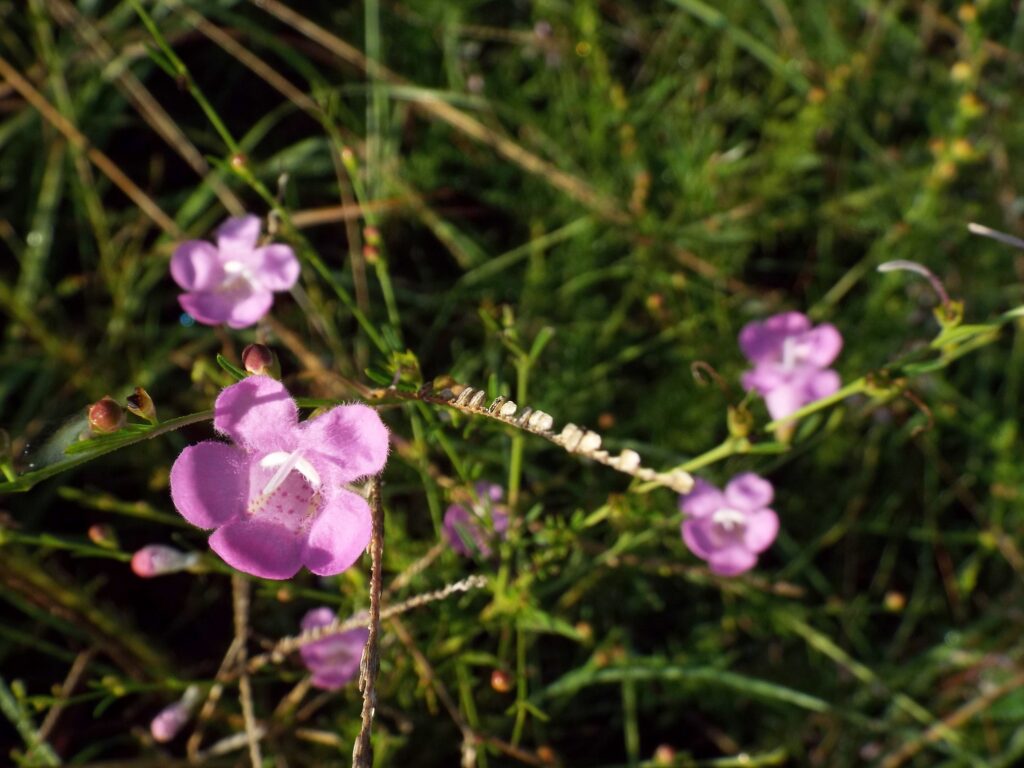
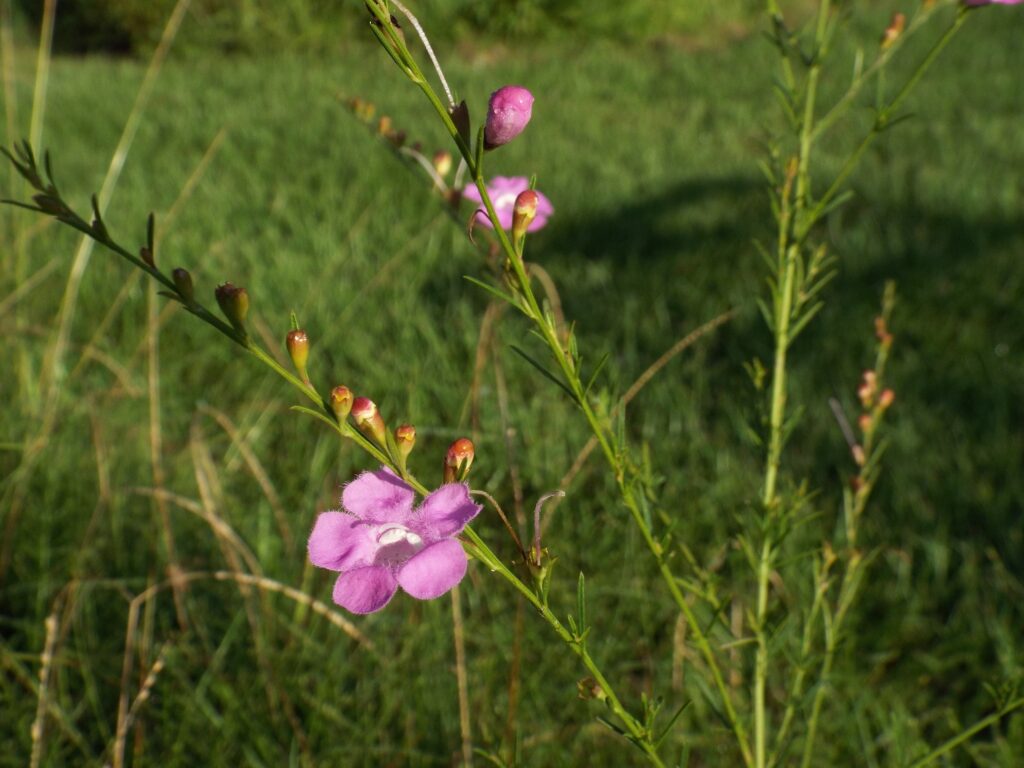
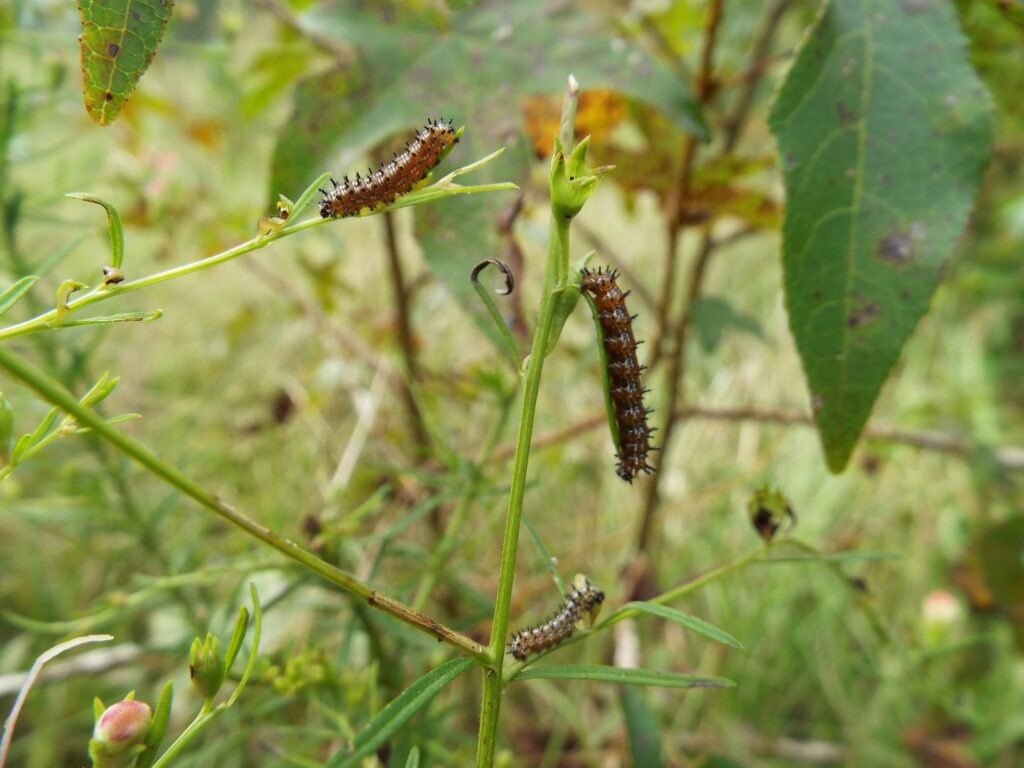
This week for Flora and Fauna Friday we have a secretly parasitic plant with a conspicuous flower and often under attack by butterflies: Purple False-Foxglove (Agalinus purpurea).
Purple False-Foxglove is a common wildflower in the Lowcountry. It’s found in fallow fields, meadows, overgrown roadsides, and other sunny, grassy habitats. We have five other species of False-Foxglove found in the Lowcountry, some rare and some common, that all have similar appearances and life histories. However, Purple False-Foxglove is by far the most common I encounter. So I’ll just be talking about that species specifically today. Purple False-Foxglove grows about three feet tall with thin, wiry stems and narrow, opposite, needle-like leaves. It’s best identified by its flowers, which blossom profusely across the plant in late summer and early fall. The blooms are a stubby five-petalled trumpet steeped in vibrant magenta with a pale-pink mouth lined by two ivory stripes and a scattering of purple spots. Its flowers are well loved by bees, of all shapes and sizes, and one particular species of butterfly. False-Foxgloves are a preferred host plant for the caterpillars of the Common Buckeye butterfly (Junonia coenia). Buckeye caterpillars are covered in dark branching spines over a body mottled in black, pearl-white, and burnt-orange. They can often be found feeding on the leaves of False-Foxglove plants. However, the Buckeyes are not the only ones mooching off a neighbor.
False-Foxgloves are interesting in that they’re parasitic. More precisely, they’re what’s known as hemiparasitic. Hemiparasites are not totally dependent on a host and can survive on their own if need be. This is why Purple False-Foxglove still has green leaves, as it is fully capable of feeding itself with photosynthesis. However, when given the chance, Purple False-Foxglove will tap into the root systems of its neighbors to siphon off nutrients. Usually, it will leach off of grasses but can parasitize most plants, including trees. Purple False-Foxglove’s love for sunny, sandy soils and ability to parasitize grasses has allowed it to carve out an interesting niche here in the Lowcountry. Fallow fields often become dominated by non-native grasses over time and hayfields are generally managed for non-native hay grasses. These habitats are very difficult for all but the hardiest of native plants to recolonize by brute force. Only a few species like Dogfennel, Nuttall’s Thistle, and Field Aster can outcompete a hay grass directly. However, Purple False-Foxglove is able to circumvent this obstacle by stealing from the grasses it’s competing against. So the better its host does, the better it does. This often makes Purple False-Foxglove the only wildflower able to overtop the hay and a welcome splash of color to the eyes in an otherwise uniform sea of green-brown grass.
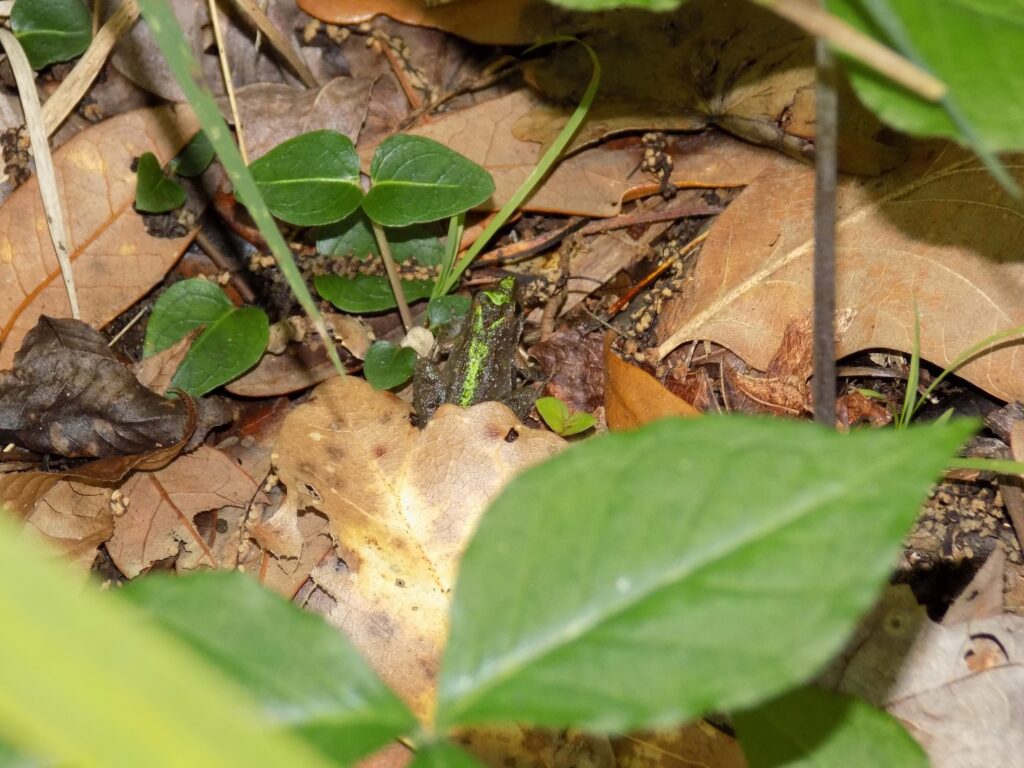
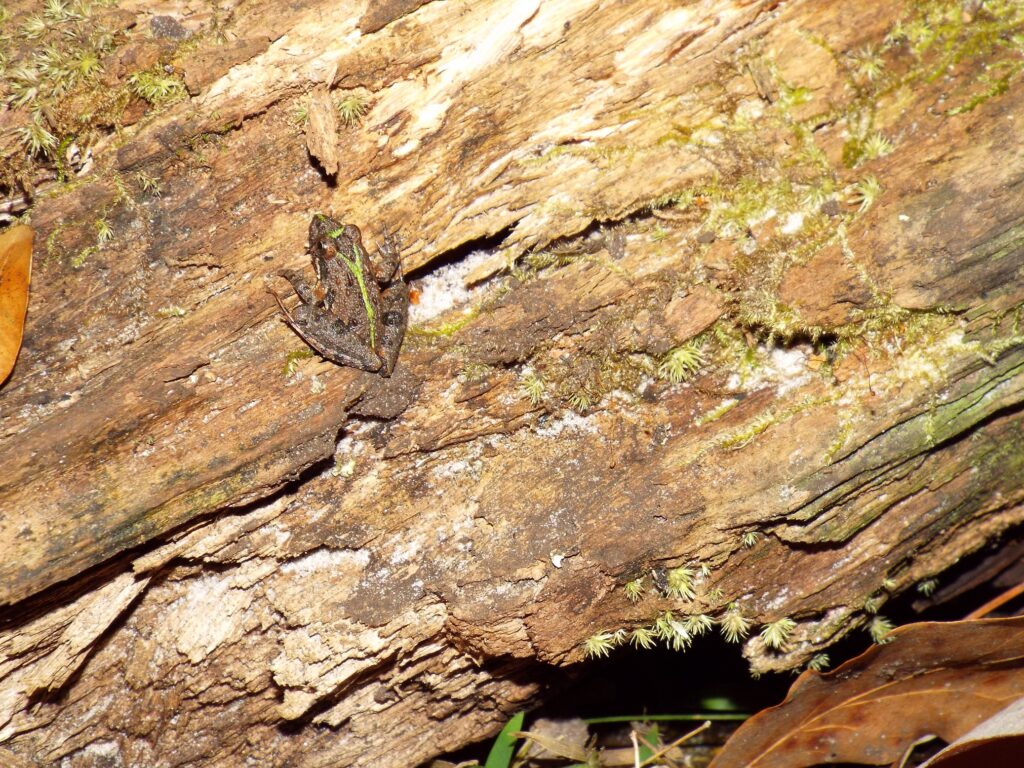
This week for Flora and Fauna Friday we have a tiny long-leaping woodland amphibian: the Southern Cricket Frog (Acris gryllus).
The Southern Cricket Frog is an abundant amphibian found throughout the Lowcountry of South Carolina, including Edisto Island. They can be found in and around most every permanent freshwater wetland on the Island but especially in swamps and other wooded wetlands. They spend more time on land away from the water than most frogs. Our Cricket Frog is tiny, the size of a fingertip, with a pointy mouth and warty skin. Their skin is mottled in drab grays and browns with a thick stripe, usually brick-red or neon-green, running up the back, splitting around the forehead, and merging at the nose. Cricket Frogs are also easily identified by their voice. The call of the male is a distinct series of high pitched chirps that speed up as the song progresses. I can best describe it as a glass marble dropped on a tile floor, slowly bouncing to a steady beat that never quite reaches the crescendo. This song has a very insect like quality, sounding like a Cricket or Katydid. Like most frogs, they require moisture to stay hydrated and standing water to breed. So they’re rarely seen far from some source of water yet are commonly seen hopping from underfoot on dry land in the forest surrounding wetlands. Cricket frogs eat small arthropods and, due to their diminutive stature, are themselves eaten by a wide array of predators. Cricket Frogs lack any weaponry but they are masters at evasion. Cricket Frogs have a massive jump for their body length. They’re able to jump about 50 times their body length, four feet or more, at a time. Their small size, long leaps, and shrill song all come together to make their common name of “Cricket Frog” quite the accurate moniker.
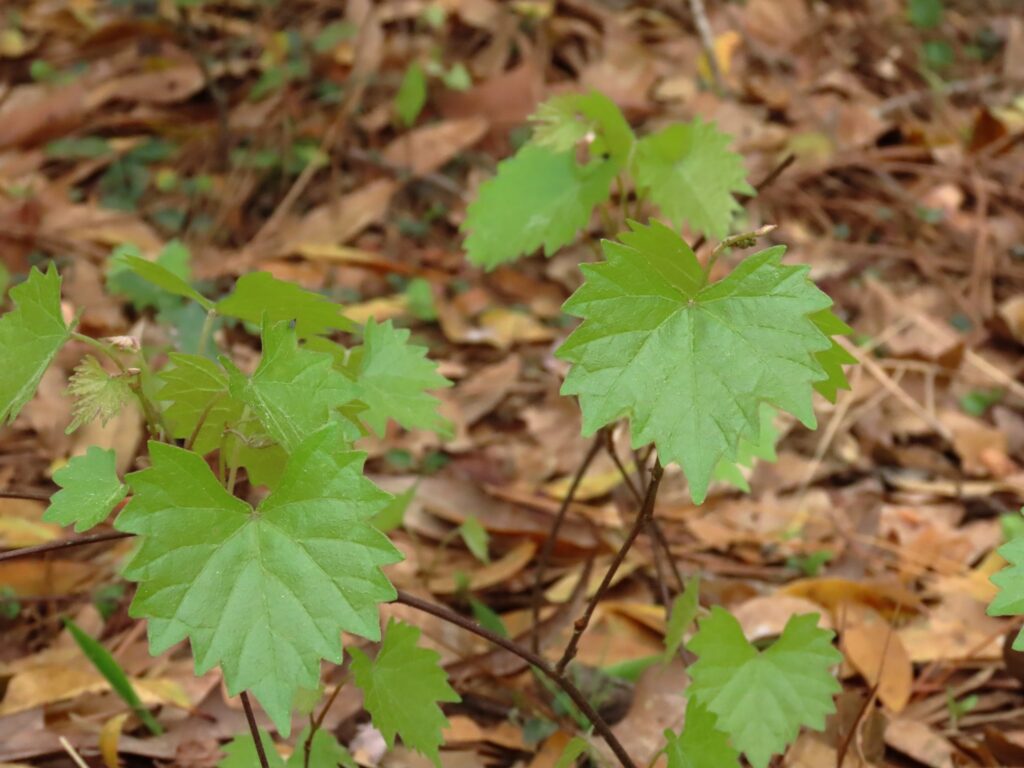
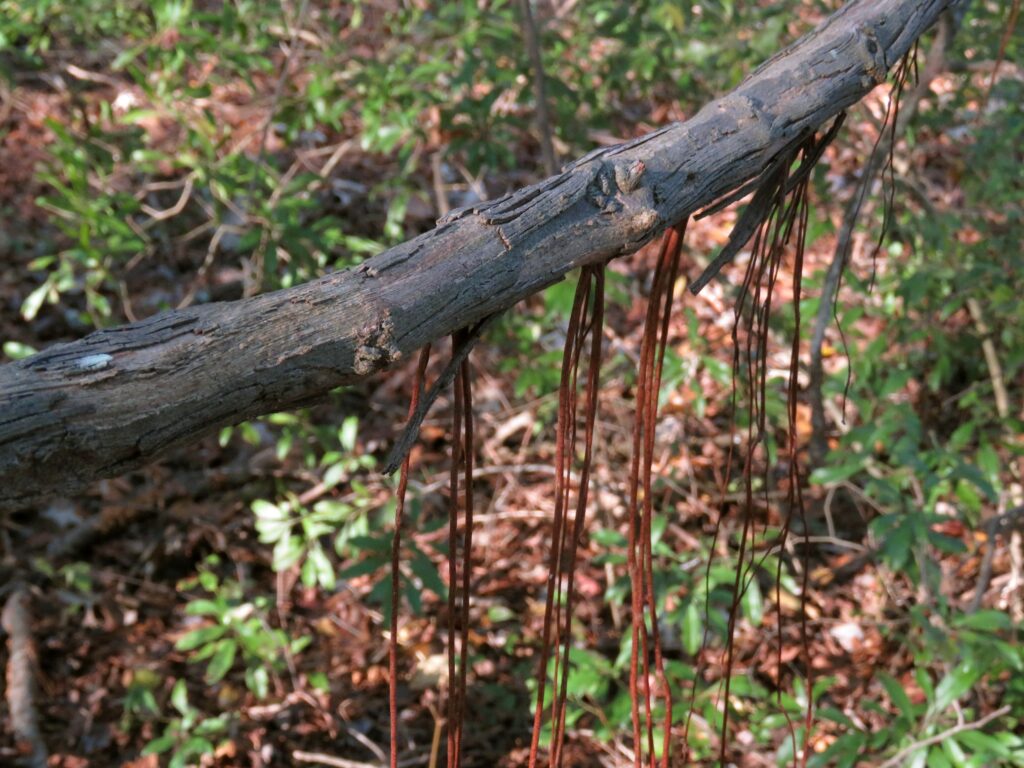
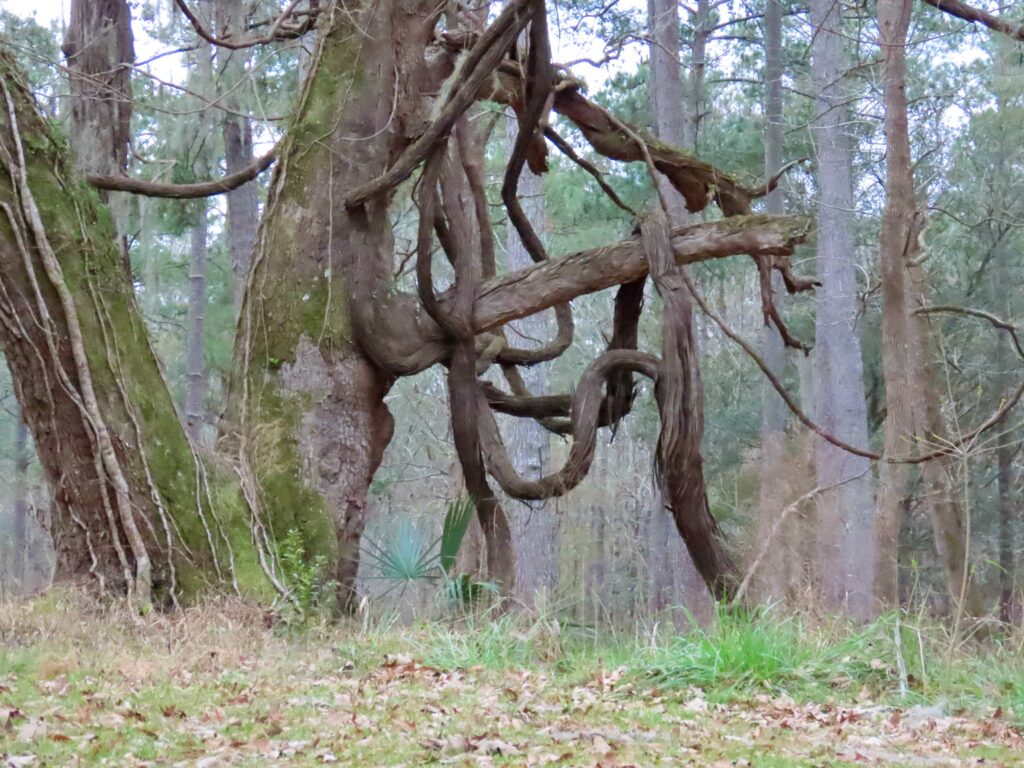
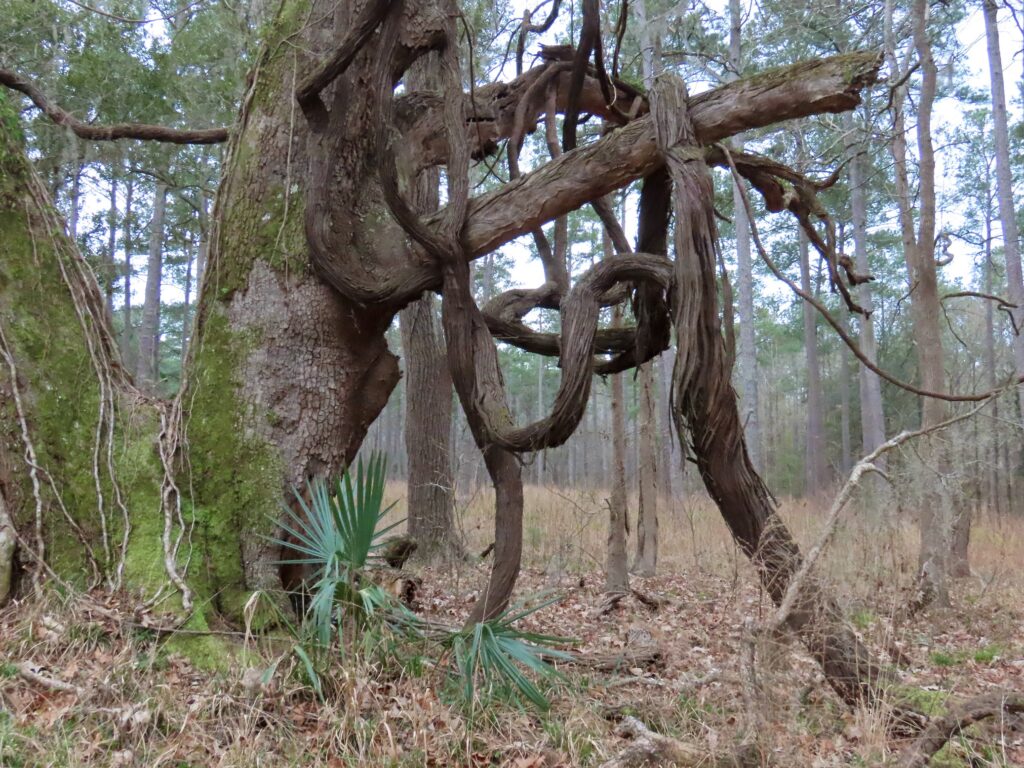
This week for Flora and Fauna Friday we have a hardy, high-climbing liana with a much celebrated southern fruit: Muscadine (Vitis rotundifolia).
Muscadine is a native species of grape found throughout the Southeast. It’s one of five species of grape native to the Lowcounty. Some of those grape species can be tricky to tell apart but, thankfully, Muscadine is by far the easiest of the bunch to pick out. Muscadine has round leaves with a coarsely serrate sawtooth margin and a glossy, smooth surface. That roughly round shape, hairless surface, and their smaller size compared to other grapes makes their leaves the fastest way to ID the species. Their vines have a furrowed bark with a warm reddish-brown color.
Muscadines and our other native Grapes climb with tendrils that wrap around twigs and small stems. They eventually dry into a death grip on whatever they’ve ensnared. Grapes climb up tree trunks and into the canopy, sometimes overtaking their host’s crown. The base of the vine thickens with age and grows outward, like a tree but slower. Over time as the vines grow and, as new tendrils form towards the tip of the vine, old tendrils snap and fall away. The thickening of the vine and shedding of old tendrils causes Grape vines to droop from slack and gravity over time, especially under broad trees like Live Oaks. As the flexible vines settle back towards Earth, they take on a gnarled, twisted form. Like a stiff rope falling back on itself, the vines twist, corkscrew, and interweave with each other. Eventually this shape solidifies as the stem ages. If one of those stems touches dirt, it will root. Sometimes, they don’t even need to touch the ground to root. Muscadines are prone to air rooting when the base of their stem is cut, they experience vascular damage, or sometimes they just do it spontaneously. Cinnamon-red roots dangle down from a vine, which may be ten feet or more high, until they touch the ground. Any root that touches soil will continue growing down and out to form an extra trunk for the vine. Muscadine is an aggressive vine. They can often grow forty or more feet up a tree and then spread across and out its canopy to smother its neighbors. To support this vigorous growth, they need to move a lot of water. If you’ve ever cut an old grape vine off of a tree, you’ve seen that the stump will seep water almost instantly like a spring. Sometimes they’ll weep for weeks on end. Their aggressive growth can be quite damaging to trees from the sheer mass of wood and water they pile up on to it. Yet Muscadine can be a boon for wildlife, and people when cultivated.
Muscadines are best known for their fruit. Wild Muscadines are dioecious, meaning there are male and female vines. Only female vines produce fruit. Grapes are botanically classified as a berry, having multiple seeds inside one soft fruit. Muscadine’s fruits are borne in clusters of just a few and have a thick rind, large seeds, and an exquisite flavor that can’t easily be put into words. Wild Muscadine grapes ripen towards the end of summer and are perfectly edible (and tasty) to humans, as well as turkeys, quail, deer, foxes, raccoon, orioles, mockingbirds, and many other species of mammal and bird. Muscadines have long been cultivated in the southeast and have been selected to create self-pollinating varieties with bigger fruits as well as the pale-colored Muscadines we know as Scuppernongs. The difference between Scuppernongs and Muscadines is a little more technical and specific than that but we’ll stick to just that generic distinction today.
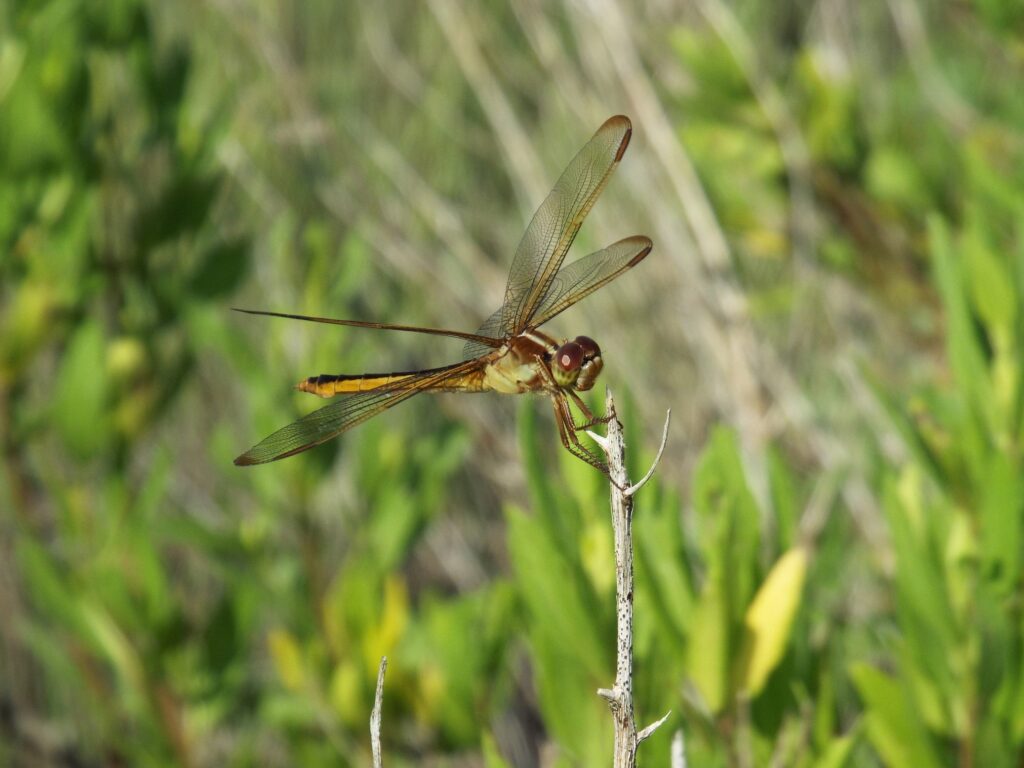
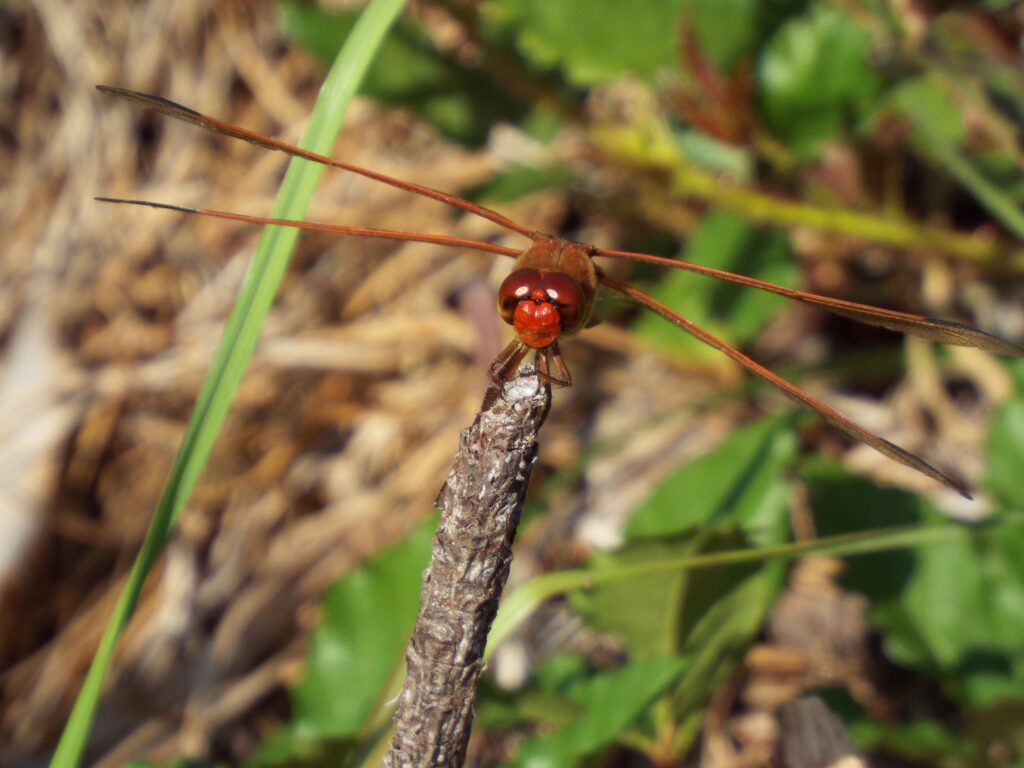
This week for Flora and Fauna Friday it’s a large fiery dragonfly found all along our coastal waters, the Needham’s Skimmer (Libellula needhami).
The Needham’s skimmer is a fairly large dragonfly that’s best identified by its brilliant coloration. Males range from street-sign yellow when young to a burnt-orange or neon-garnet when mature. The bulk of their color is on their abdomen but, in mature males, that’s matched by deep red eyes and an equally colorful mouth. Females are more subdued and range from lemon-yellow to a dull beige. Both sexes sport a colored stigma at the wing tip with a trail of translucent orange or yellow down the leading edge. Both males and females have a black stripe that runs down the full length of the back of the abdomen. There is another very similar species called the Golden-winged Skimmer that is found more inland. The Golden-winged Skimmer isn’t found on Edisto Island, so I won’t go into fine detail, but the easiest way to tell the two apart is by the pattern on the side of the thorax in females and juveniles. Golden-winged has diagonal lines leading from wing to leg whereas Needham’s has a pale blotch that points towards the neck. The two species don’t often occur together but both can be found in the Lowcountry.
Needham’s Skimmer are an easy species to spot here in the coastal plain. Not only are they brightly colored but they love to wander about at eye level and perch along marshes and open ponds. They dart out over fields, marsh, and water to grab insects on the wing. This species is very common in the Lowcountry and can be found along the outskirts of most any tidal river. Needham’s Skimmers breed in brackish wetlands and are prolific around the outskirts of the saltmarsh. During much of the summer they’re often the most numerous dragonfly around the Island.
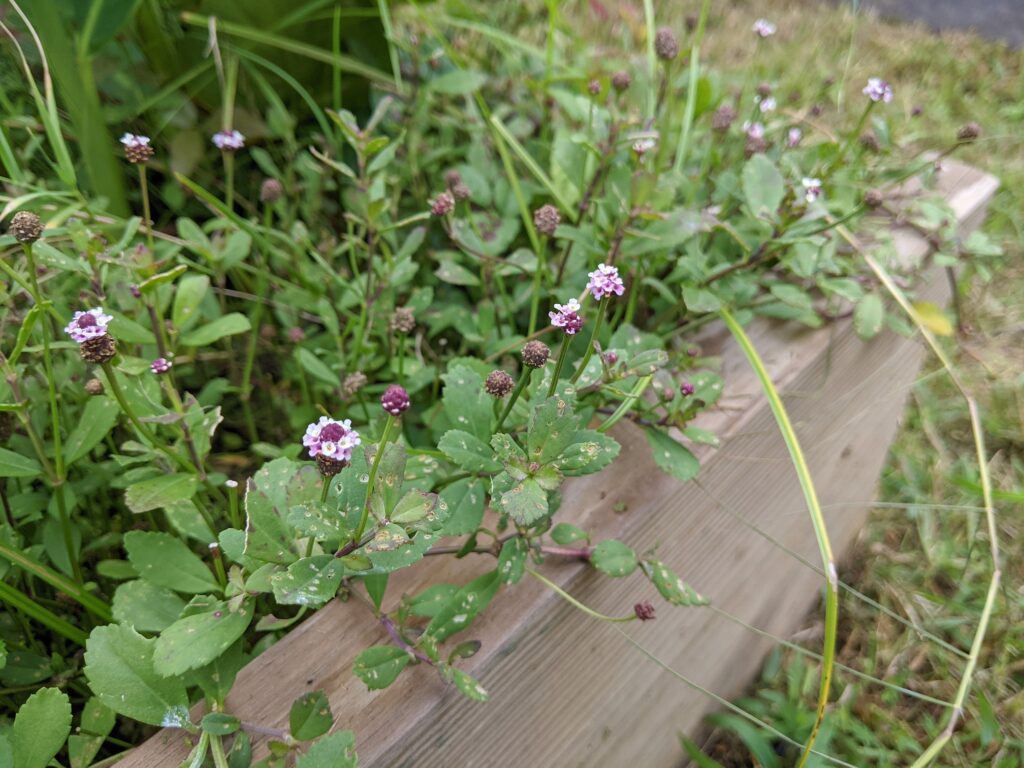
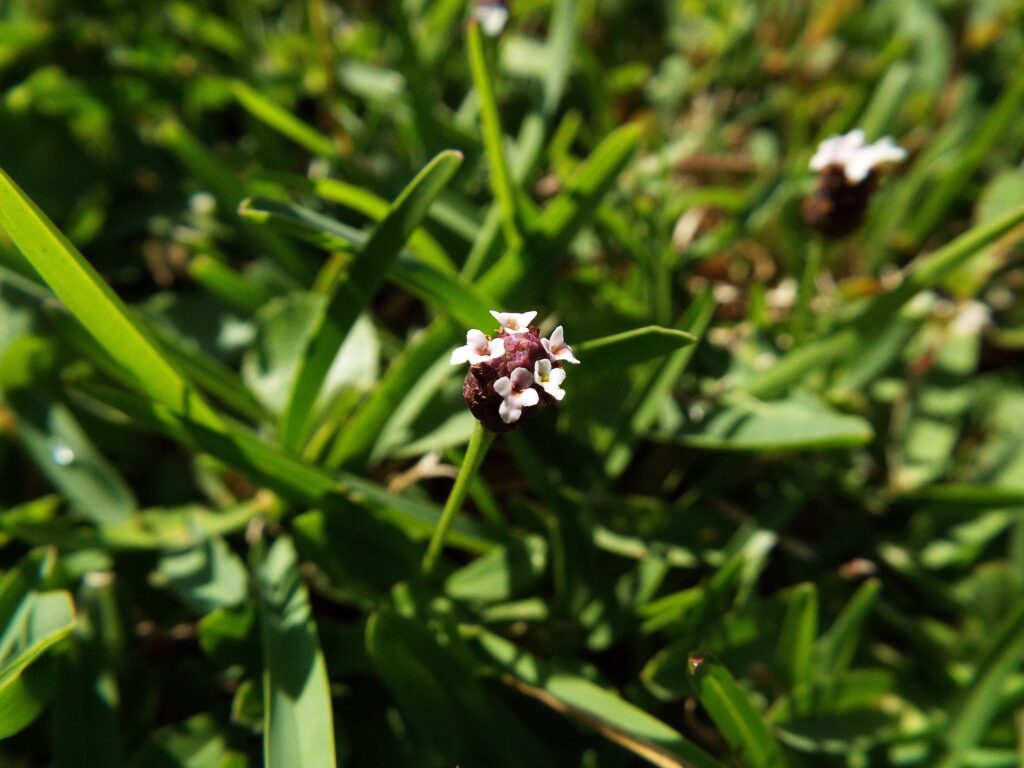
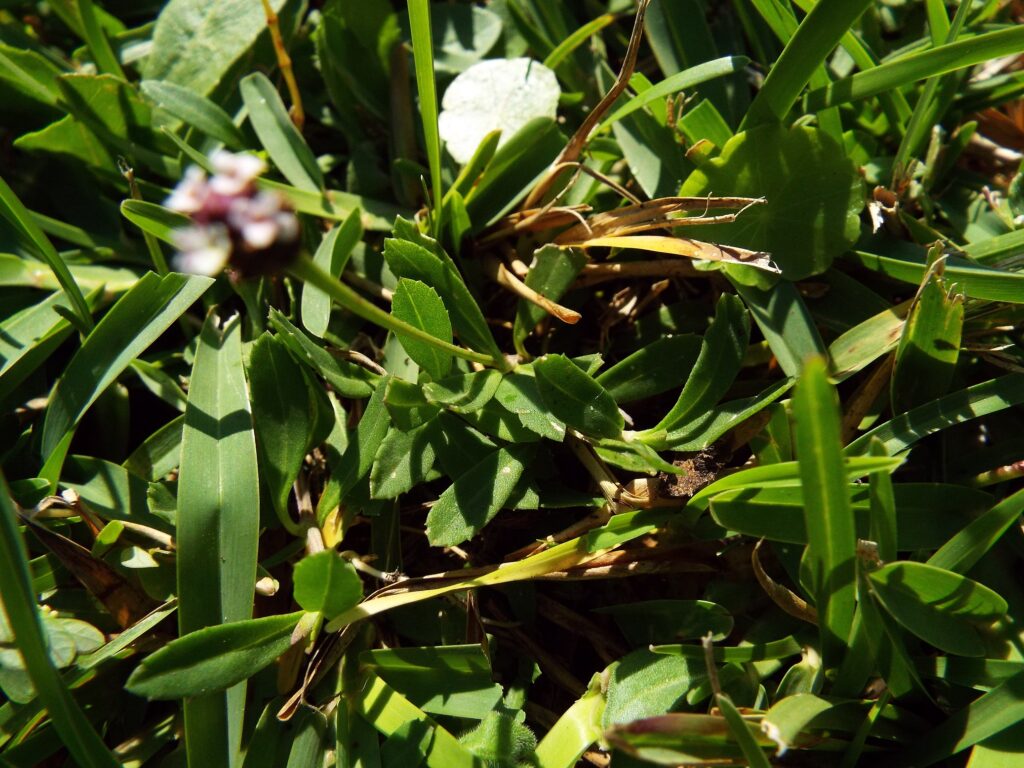
This week for Flora and Fauna Friday we have a wildflower that’s as resilient as it is short: Frogfruit (Phyla nodiflora).
Frogfruit is a member of the Verbena family and a relative of Lantana and Vervain. It’s found throughout the coastal plain of the southern United States, including the Lowcountry of South Carolina. Frogfruit is a low growing groundcover, often less than 4 inches tall. It’s a perennial broadleaf plant with semi-evergreen and somewhat succulent leaves and a habit of densely spreading along its creeping stems. This little plant is found in a wide variety of habitats but, due to its short stature, needs exposed soil and occasional moisture to thrive. However, Frogfruit isn’t picky about where it lives as long as it doesn’t get buried by other vegetation. It will tolerate a lot of disturbance, including partial shade, scorching heat, intermittent flooding, prolonged drought, saltwater, chemical contamination, and poor soils. It can often be found growing along brackish ponds, in parking lots, on shellsand driveways, and over brick pavers. This resiliency and durability make Frogfruit a great lawn substitute in many places. It grows densely and vigorously into a turf in most soils and light conditions, as long as it gets sufficient water, and, once established, it is hard to get rid of.
A benefit to Frogfruit over traditional turf-grasses is that it is both a tremendous nectar plant for pollinators and a host plant for two species of butterfly: the White Peacock (Anartia jatrophae) and the Phaon Crescent (Phyciodes phaon). Frogfruit blooms pretty much continuously from April to November and is frequented by an uncountable number of pollinators, both large and small. Frogfruit’s flowers are clustered together at the tip of a short stalk on a spherical or cylindrical flowerhead. These flowerheads have a mauve cap ringed by a skirt of tiny white-pink, upward facing flowers, each with a lemon yellow or magenta center. Flower stalks are prolific too, with each only being a few inches from the next across the whole of the plant. Frogfruit is an all-around positive addition for wildlife in any garden, lawn, or habitat.